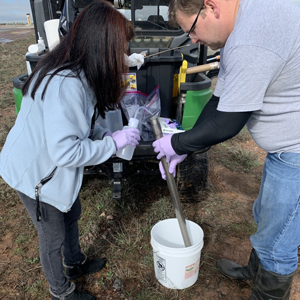Research supported by NIEHS is helping to better assess and reduce exposure to a group of chemicals known as PFAS. These per- and polyfluoroalkyl substances (PFAS), which are added to many consumer products to make them nonstick, waterproof, and stain-resistant, persist in the environment and are sometimes referred to as “forever chemicals.” PFAS have been linked to a variety of health effects, including changes in immune and liver function, obesity, diabetes, certain cancers, and lower birth weights.

Federal public health and environmental agencies recently took significant steps to reduce exposure to PFAS. In January, the Centers for Disease Control and Prevention (CDC) published PFAS Information for Clinicians explaining how and when to order blood tests for patients exposed to PFAS. In February, the U.S. Food and Drug Administration (FDA) announced the phaseout of PFAS substances used to grease-proof paper food packaging. And in April, the Environmental Protection Agency (EPA) established the first-ever legally enforceable PFAS drinking water standards to limit the amount of six PFAS in public water systems (see sidebar). Studies led by NIEHS scientists and grant recipients factored into the agencies’ decision making.
Scott Masten, Ph.D., who directs the Office of Portfolio Strategy in the NIEHS Division of Translational Toxicology (DTT), discussed the recent PFAS measures and what people can do to reduce their exposures.
Environmental Factor (EF): How did NIEHS contribute to the science behind the new guidelines to help doctors and health care providers diagnose PFAS exposure?
Masten: NIEHS and the CDC/Agency for Toxic Substances and Disease Registry [ATSDR] jointly funded a National Academies of Sciences, Engineering, and Medicine study to look at the issue of clinical guidance for PFAS exposure and to develop recommendations. The committee met for several years, and they issued a report in 2022 that evaluated the most current evidence available on the human health effects associated with PFAS exposure. This report, which is now widely cited and used by clinicians everywhere, led to the CDC updating their clinical guidance for PFAS testing.
EF: What research led to the phaseout of PFAS from fast-food wrappers, takeout containers, and other products like microwave popcorn bags?
Masten: The FDA conducted its own toxicology research, and it relied heavily on that research for the 2020-2021 actions that led to the recent phaseout. As part of the agency’s consideration of the overall evidence, the FDA cited a National Toxicology Program report highlighting the health effects of one type of the PFAS called perfluorohexanoic acid.
EF: What have we learned about reducing PFAS exposure from NIEHS grantees?
Masten: Most people are exposed to PFAS through contaminated drinking water or food, so one thing they can do is to first learn how much PFAS is in what they drink and eat.
The “What’s My Exposure” online tool developed by PFAS-REACH, an NIEHS-funded collaborative project, can show people how the PFAS levels in their drinking water or blood compare to state and federal health guidelines. The tool generates a personalized report based on the PFAS levels input and offers suggestions to reduce exposure. For example, using filters to remove PFAS from drinking water may help.
Eating out less may reduce exposure, too. NIEHS-supported research has shown that people who prepared foods at home had lower blood levels of PFAS than those who ate out. In addition, eating a high-fiber diet may decrease disease risks linked with PFAS.
(Caroline Stetler is Editor-in-Chief of the Environmental Factor, produced monthly by the NIEHS Office of Communications and Public Liaison.)









